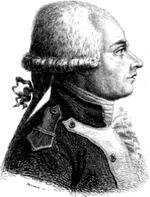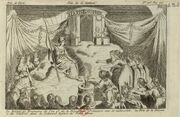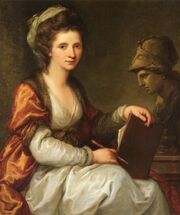Le peuple français reconnoit l'Etre Suprême et l'immortalité de l'âme[1]
(Laws of Brumaire of year VII)
I believe in one God, and no more; and I hope for happiness beyond this life. I believe in the equality of man; and I believe that religious duties consist in doing justice, loving mercy, and endeavoring to make our fellow-creatures happy.
(Thomas Paine)
The Cult of Reason (French: Culte de la Raison) is form of Deism established in France as state-sponsored Deistic and civic religion, intended as a replacement for Roman Catholicism during the French Revolution. Formally organized as the mandatory public worship during the Directory (1796-1801) and Grand-Electorship (1801-1809).
Origins of Deism[]
Deism is a theological theory concerning the relationship between a creator and the natural world. Deistic viewpoints emerged during the scientific revolution of 17th-century Europe and came to exert a powerful influence during the 18th-century Enlightenment. Deism stood between the narrow dogmatism of the period and skepticism. Though Deists rejected atheism they often were called "atheists" by more traditional theists. There were a number of different forms in the 17th and 18th centuries that mainly emerged in the Commonwealth and France.
In England, the term Deist first appeared in Robert Burton's The Anatomy of Melancholy (1621). Lord Herbert of Cherbury (1583–1648) is considered the "father of English Deism", and his book De Veritate (1624) the first major statement of Deism. Deism flourished in Britain between 1690 and 1740, at which time Matthew Tindal's Christianity as Old as the Creation (1730), also called "The Deist's Bible," gained much attention. In the 18th century, in the Commonwealth, Deists included a range of people from anti-Christian to non-Christian theists. Later Deism spread to France (notably through the work of Voltaire), to Germany, and to North America.
France had its own tradition of religious skepticism and natural theology in the works of Montaigne, Bayle, and Montesquieu. The most famous of the French Deists was Voltaire, who acquired a taste for Newtonian science, and reinforcement of Deistic inclinations, during a two-year visit to England starting in 1726. However, continental Deism was highly critical of the established Catholic Church, and has the authors of the Encyclopedia emphasizing the hold of the Church on society was a hold on progress and scientific knowledge and part of the sections of society that opposed the pursuit of improvement and happiness of man and society. Thus, this in part explains the onslaught of Continental secularism and the establishment of organized Deism.
Establishment of Organized Deism[]

The Eye of Province. Masonic and Deist symbol.
The Cult of Reason was a forced merger of various forms of Deism, promoted and propagated by the more radical republican elements. In earlier part (1788-1797) several Deist cults were first established and erratically promoted with no clear organization or creed by local authorities. These local and regional cults later evolved into the most important ones: the Cult of Reason (1793), the Cult of the Supreme Being (1793) and Theophilanthropists (1795). All these Deist cults were influenced by British Deism and the Freemasonry.
Atheism was frowned on as amoral, decadent and aristocratic and contrary to the spiritual and moral renewal of a republican society.
However, as part of the divisions and infighting among republicans many participants were denounced as anti-revolutionaries depending on whose side they were on.

Antoine-François Momoro French Printer, Politician, and Revolutionary. Main promoter and propagandist of the Cult of Reason
In 1797, the Directory promoted the Cult of Reason as an official policy (Laws of Brumaire of year VII). Its creed and philosophical tenets were more clearly defined, places of gathering and ceremonies created, authorities established for its direction and manuals published. All other Deist cults were required to join it or be declared illegal. The majority of the followers, propagandists, preachers and authorities came from the ranks of the Theophilanthropists that enjoyed a wide popularity and following in the low and middle social classes.
In its beginnings this state policy clashed with the officially sanctioned Catholic Constitutional Church (Gallican Constitutional Church) in priorities, finances and public support. Several times riots of opposing juror and non-juror Catholics raiding temples of the cult, and iconoclast or disruption of mass campaigns by members of the Cult or authorities organized.
Under the Grand Electorship the Cult of Reason became a normal part of society and everyday life and it took its definitive form. It famously decreed that all cemetery gates must bear only one inscription — Death is an eternal sleep.. The inscription was kept in years to come in all civil cemeteries, the ones used by the majority of the French population.
The Consulate, though withdrawing official sponsorship, kept it and for some years sustained its worship and as a major part of civic education in schools. The Cult under the aegis of the Consulate spearheaded the legislation for the complete separation of Church and State.
State administration and promotion was carried out by the Committee for Public Worship and Religious affairs (1791-1796), the Ministries of Public Education and Public Worship (1796-1801), of Cult and Religious Affairs (1801-1809). From 1820, all mandatory and legal powers and directory supervision over the Cult by the Ministry of Public Worship and Religious Affairs (1809 to date) were rescinded. To this date the ministry only supervises all religious worship in France and its territories and the oversee constitutional separation of the Churches and the State.
As a means to promote the Cult and places for worship several churches were nationalized, renamed and given to the Cult to administer. The mayor ones being the Panthéon des grands hommes or Temple de l'Humanité (later designated as the National Civic Mausoleum - or National Panthéon), Notre-Dame de Paris (Temple de l'Être suprême), Saint-Sulpice (Temple de la Victoire), Saint-Germain-l'Auxerrois (Temple de Reconnaissance), and Saint-Eustache (Temple de l’Agriculture).
When the Consulate negotiated a Concordat and re-established the Catholic Church of France (1811) the majority were given back to ecclesiastical administration. New buildings for consistories were built, the temples of reason with its characteristic layout imitating the Parisian Panthéon.
Religious Tenets[]

Representation of earlier Festivals of Reason
The Cult of Reason is a natural religion. Its main tenet (or belief) is the recognition of the existence of the Supreme Being and the immortality of the soul - with a rational worship (institution of feasts devoted to civic virtues) whose aim is to develop civic republican morality.
Worship at first was very simple and meant chiefly for the home and small gatherings: it consisted in a short invocation of God (or Reason or the Supreme Being), the reading of a text and hymn and a kind of examination of conscience at the end of the day. Later a more developed worship was created for the Temples of Reason. A plain altar on which were laid some flowers and fruits, a few inscriptions appended to the walls, a platform for the lecturer-supervisor, lecturer, assistant-reader or orators/speakers, were the only furnishings allowed. It included allegorical representations of Reason, the centerpiece and in certain cases - such as the Festival of Reason - impersonated by a woman.
The main massive public gatherings are the Festivals of Reason, held every tenth day[2] or on public holidays.
The moral and civic teaching is considered the principal feature of the Cult and the main issue of the preaching of lecturers and orators or speakers). Youth confirmations, a coming of age ceremony practiced by 14-year-olds, was established as an alternative to the Christian baptism and confirmation.
The main writings are:
- Manual of the Cult of Reason (Manuel du Culte de la Raison) the main source of the creed of Deism. It has a section on the organization of the Cult and election of its authorities.
- Hymnal (Hymnaire). A collection of hymns, poems, and quotes used in services and gatherings.
- Religious and Moral Code of the Cult of Reason (Code religieux et moral del Culte de la Raison). A manual or code of conduct for the Cult. It also contains a brief summary and explanation, for educational purposes, of the basic tenets of the Cult of Reason.
The main services of the Cult, the moral days (jours de morale), most officially established by Directorate and Grand-Electorship are the following:
- Fête aux bienfaiteurs de l'humanité (21 brumaire). Commemorates Voltaire’s birthday and the benefactors of Humanity
- Fête anniversaire de rétablissement de la Culte de la Raison (25 brumaire). Date of the first Laws of Brumaire of year VII, 1797 that established the Cult of Reason. One of the two major days and festivities.
- Fête de la Tolérance (15 frimaire)
- Fête aux bonnes moeurs (15 nivôse)
- Fête de la jeunesse (10 germinal)
- Fête des époux (10 floréal)
- Fête de la Reconnaissance (10 pradial)
- Fête de la Raison, Fête de l'Être suprême or Fête de Culte de l'Être suprême (20 prairial). One of the two major days and festivities.
- Fête de l'Agriculture (10 messidor) No longer a moral day after the Consulate made it a civic day. However some branches still celebrate it.
- Fête de la Liberté (9 et 10 thermidor)
- Fête des vieillards (10 fructidor)
- Fête de la Justice et de clémence (18 fructidor)
Organization[]
The Decree of 1797 mandated that participants in each district gather in circles, congregations or consistories for purposes of worship, reflection and education. Each group would elect a directory to manage the local needs and organize its activities. The Lecturer-supervisor (lectilecteur-surveillant), the assistant-lecturer (lecteur-adjoint) and the moderators elected by the Directory would be in charge of guiding the group and its weekly meetings. Besides the lecturers that guide the services, the sermon and hymns, also speakers can be invited or called to preach or give out a sermon.
There were no provisions for regular meetings of district or departmental groups. District groups meet on mutually agreed or special cases such as the election of delegates (moderators) to national conventions. National Conventions were summoned at irregular intervals by the national French government on petition of the local directories. From these conventions were the manual, hymnal and code redacted and approved. In 1802, the Grand-Electorship decreed to organized district, departmental and national managing elected directories. Providing that each body be elected by the representatives of the lower administrative unit or the whole congregation in the case of the district directory.
The Decrees of 1797 and 1802 provided that all adult members elect its moderators and lecturers, including women to be candidates to all posts, vote and be elected. This was important considering that full political voting rights for French women would be granted in the 1830s.
Its Diffusion and Spread[]
The Cult of Reason spread among the sister republics[3], Rhenania, Netherlands[4], the American republics and Iberia[5], Illyria[6], Scandinavia[7], Poland-Lithuania[8] and Haiti[9].
In Austria, Prussia and other central European countries its propaganda and practice was forbidden due to its link with Revolutionary France.
In Royalist Louisiana it was explicitly banned and denounced by the Catholic Church as immoral and heretical. It received the same treatment as Voodoo-Hoodoo until the establishment of the Republican Louisiana, and secessionist Dakota, that declared freedom of worship.
In the Commonwealth it was a brief novelty and later practiced by the more educated and skeptical of the National Churches - besides competing with the Freemasonry that had an important following in aristocratic and oligarchical circles. Public gatherings and services were limited or prohibited by the Alien Associations Act that restricted the activities of non-British organizations such as the French Cult of Reason. Being relegated to private halls and household parlors hindering a larger following. However a major change that was made was the contact and dialogue between Deism, Socinianism, Baptist and Quaker traditions that led to the development of Unitarianism as the union of Deism and Non-trinitarianism Christianity.

Gaëlle Monette renowned French lecturer and later National Director of the Cult and delegate to Le Confrérie
However, across the Atlantic commonwealths and American republics, and the Mediterranean (Italian Peninsula, Spain, Portugal and Illyria) it gained an important foothold. In Spain and Portugal it was a steadfast of Iberian republicanism. On the proclamation of the republics of Spain and Portugal this link provided for the separation of Church-State and the adoption of the Italian-Iberian Calendar.
The first international convention of Deist chapters and organization from France, Flanders, Rhenania, Helvetia, Hannover-Westphalia, Dutch Republic, Etruria, Italian Republic, Piedmont and Illyria met in Paris in 1811. It approved revised versions of the Manual, Hymnal and Code. It agreed to mutual recognition of moderators, lecturers and organizers. And finally the international convention also voted that in order to foster friendship, cooperation and the spread of the Cult the establishment of an international union - The Fellowship (Le Confrérie).
The Helping Hand (Main d’Aider) is a volunteer network of fraternal help. As a humane charity it follows the parable of the Good Samaritan and does not distinguish beliefs and creeds in helping the needy. The Helping Hand has a welfare network of soup kitchens, hospitals, shelters, orphanages and eldercare.
Later Development[]
French India brought contact with Hinduism and Buddhism substantially influencing the Cult of Reason. At first both creeds were treated as subjects of scholarly study and commentary, and elements such as karma, vegetarianism and meditation treated as part of the exotic East. However the appealing character of karma, vegetarianism and meditation made closer inspection of its apparent naturalistic outlook within the Cult’s faith and practice.
Some moderators, the so-called Brahmins, tried to infuse elements of Hinduism veneration to the Worship and services of the consistories with mixed success. Vegetarianism was more successful and the followers of Cult key in promoting and establishing vegetarian societies and restaurants.
Meditation techniques became more widespread and guides, teachers and the printing of additions to the Manual on the virtues of meditations and its techniques, These additions became so common.that some branches treated them as integral part of the teaching of the Cult. Gatherings for group meditation or retreats were established and the meditation cloisters and pavilions were built with this purpose with major temples having attached structures for this.
Confucianism, understood as a humanistic or rationalistic religion and way of life also influenced the Cult in a further development and discussion of rationalist ethics. Confucianism also proved that rationalism was possible as an alternative to Christian dogma.
Some groups advocated elements of nature religion following the premises of Japanese Shinto, "the first naturalistic religion", and promoted environmental consciousness.
| |||||||||||||||||||||||
- ↑ The French people recognize the Supreme Being and the immortality of the soul
- ↑ The end of the ten day week in the French Republican Calendar. Substituted for the seventh day in the places that followed the Gregorian or Italo-Iberian calendars.
- ↑ German: Kult der Vernunft, Italian: Culti della Ragione
- ↑ Dutch: Cultus van de Rede
- ↑ Spanish: Culto de la Razón, Portuguese: Culto da Razão
- ↑ Slovene and Croatian: Kult Razuma
- ↑ Danish: Kult af fornuft, Swedish: Kult av förstånd, Norse: kult av fornuft, Finnish: Järjen palvonta
- ↑ Polish: Kult Rozumu, Lithuanian: Proto kultas, Russian: Культ Разума
- ↑ Kreyol: Kilt nan rezon

